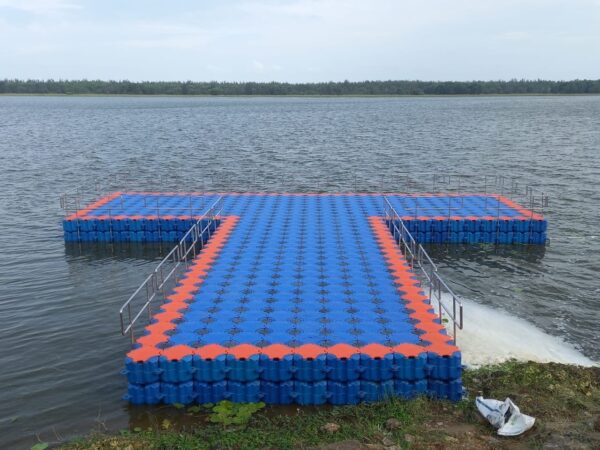A floating dock, as the name suggests, is a platform that rests on the water’s surface, is buoyant, and is adaptable to changing water levels. Unlike traditional fixed docks, which are anchored to the shore, floating docks remain afloat and rise and fall with the water. The construction of floating docks typically involves a framework of buoyant materials, such as plastic, foam-filled floats, or even air-filled barrels, providing the necessary buoyancy.
1. Versatility in Design: Adapting to Water Conditions
Floating docks are celebrated for their adaptability to fluctuating water levels. This makes them ideal for locations with tidal variations or bodies of water prone to seasonal changes. The modular design of floating docks allows for easy adjustments, ensuring that the structure remains stable and accessible even in the face of water level fluctuations.
Whether in serene lakes, bustling marinas, or coastal areas, floating docks find applications in diverse environments. In areas like coastal regions where the water level can change dramatically, floating docks offer a reliable and practical solution for maintaining consistent access to the water.
2. Construction Materials: Balancing Strength and Buoyancy
The materials used in the construction of floating docks play a crucial role in determining their strength, durability, and buoyancy. Common materials include high-density polyethylene (HDPE), aluminum, and pressure-treated wood. Each material brings its unique set of advantages, addressing specific needs and preferences in different settings.
HDPE floating docks are known for their durability, resistance to corrosion, and low maintenance requirements. Aluminum floating docks offer a lightweight yet robust solution, ideal for applications where ease of installation and longevity are paramount. Wooden floating docks, treated to withstand water exposure, provide a classic aesthetic while ensuring structural integrity.
3. Modular Configurations: Tailoring to Unique Needs
One of the standout features of floating docks is their modular design, allowing for customizable configurations to suit various needs. The modular nature of these docks enables easy assembly, disassembly, and reconfiguration, providing flexibility in adapting to different waterfront layouts.
This modular versatility makes floating docks an excellent choice for both residential and commercial use. In residential settings, property owners can customize the layout to accommodate personal watercraft, swimming areas, or fishing spots. Commercial marinas can optimize their space by configuring floating docks to accommodate a range of vessel sizes and activities.
4. Accessibility and Ease of Installation: Simplifying Waterfront Access
Floating docks excel in providing accessible waterfront access, offering a level platform above the water’s surface. This ease of access is particularly valuable for recreational activities such as kayaking, paddleboarding, and swimming. Unlike fixed docks, floating docks eliminate the need for steep gangways, making them more user-friendly for individuals of all ages and abilities.
Installation of floating docks is generally more straightforward compared to their fixed counterparts. Their modular components often come pre-fabricated, reducing on-site construction time and minimizing disruption to the surrounding environment. This ease of installation contributes to their popularity in both residential and commercial applications.
5. Commercial Applications: Enhancing Marina Dynamics
Floating docks play a pivotal role in enhancing the functionality and efficiency of commercial marinas. The adaptability of floating docks to changing water levels ensures that marinas can maintain consistent berthing options for vessels of varying sizes. This is especially crucial for marinas situated in tidal zones or locations with seasonal water level fluctuations.
In commercial marinas, floating docks are often configured to create designated areas for different types of vessels, such as sailboats, powerboats, and yachts. The modular design allows marina operators to optimize available space, increasing the number of berths and maximizing revenue potential.
6. Environmental Considerations: Minimizing Ecological Impact
Floating docks, with their buoyant design, minimize their ecological impact on the surrounding environment. Unlike fixed docks, which can disrupt underwater ecosystems and hinder the natural flow of water, floating docks allow for the passage of light and water beneath the structure. This fosters a healthier aquatic environment and supports the well-being of marine life.
In ecologically sensitive areas where preserving the natural balance of the ecosystem is paramount, floating docks emerge as environmentally friendly alternatives. Their minimal footprint and adaptability contribute to sustainable waterfront development practices.
7. Maintenance and Longevity: Sustaining Investment Value
Floating docks, when constructed with quality materials, are known for their longevity and minimal maintenance requirements. High-density polyethylene and aluminum, in particular, are resistant to corrosion, rot, and degradation caused by prolonged exposure to water. This durability ensures that floating docks can withstand the rigors of constant water contact and weather extremes.
The buoyant components of floating docks are designed to resist water absorption, preventing structural issues that can arise from prolonged submersion. Routine maintenance typically involves inspecting connections, securing decking, and ensuring that the buoyant elements remain intact, contributing to the sustained value of the investment.
8. Recreational Use: Creating Waterfront Destinations
In residential settings, floating docks become focal points for recreational activities, transforming waterfront properties into vibrant destinations. From providing a platform for sunbathing to serving as launch points for water sports, floating docks enhance the overall enjoyment of waterfront living.
Whether extending into serene lakes or bordering lively rivers, floating docks create inviting spaces for family gatherings, fishing excursions, and leisurely moments by the water. Their adaptability allows homeowners to personalize these spaces, incorporating amenities such as seating areas, swim ladders, or even integrated lighting for evening enjoyment.
9. Future Innovations: Paving the Way for Waterfront Solutions
As technology and design continue to advance, the world of floating docks is poised for future innovations. From incorporating sustainable materials to integrating smart technologies for enhanced functionality, the evolution of floating docks reflects a commitment to meeting the evolving needs of waterfront communities.
Innovations such as solar-powered lighting, eco-friendly decking materials, and smart docking systems that monitor water conditions are on the horizon. These advancements aim to enhance the sustainability, efficiency, and overall user experience of floating docks, ensuring they remain relevant in the ever-changing landscape of waterfront development.
Conclusion
In conclusion, floating docks stand as dynamic solutions that navigate the waters of diverse environments, from residential waterfronts to bustling marinas. Their buoyant design, versatility in configuration, and adaptability to changing water levels make them integral components of waterfront infrastructure.
Whether providing accessible recreation in residential settings or optimizing berthing options in commercial marinas, floating docks offer a harmonious blend of functionality, durability, and environmental sensitivity. As the demand for waterfront living and recreation continues to grow, floating docks pave the way for sustainable and enjoyable experiences along the shores of lakes, rivers, and coastal areas.















Be First to Comment